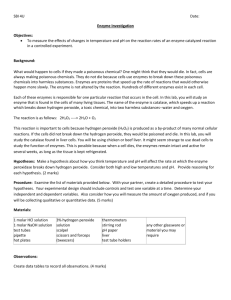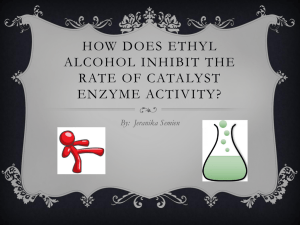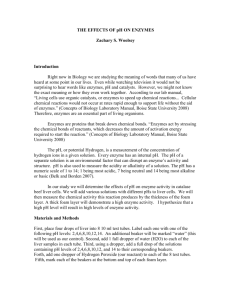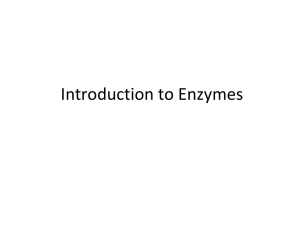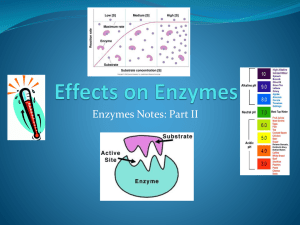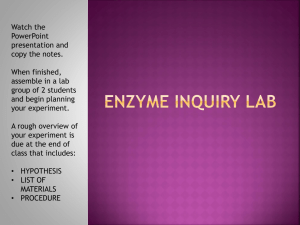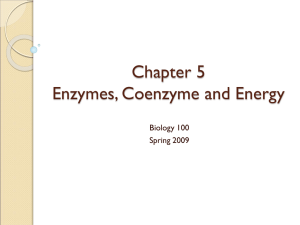ATP
advertisement
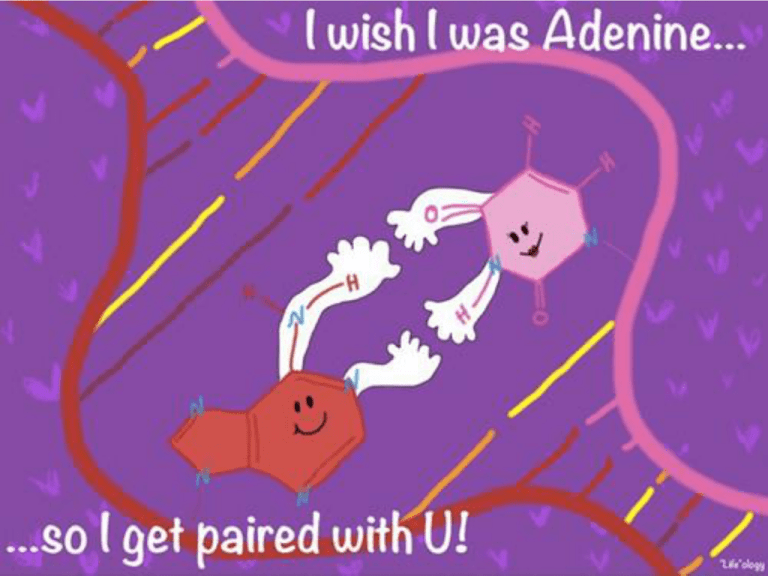
Reminders Biosphere Observations – Note: there will be NO tutorial on Friday! Question of the Day Question: Describe the structure and purpose of DNA. Answer: … … … Organisms and pH 1. Summarize the effects of HCl and NaOH on tap water. 1. Adding HCl and NaOH had large effects on the pH of tap water, greatly reducing and raising the pH respectively. 2. Summarize the effects of HCl and NaOH on biological materials, like orange juice and egg whites. 2. Adding HCl and NaOH had small effects on the pH of biological materials, changing their pH very little. 3. When you added HCl and NaOH to the buffer, was it more similar to a biological material or tap water? 3. The buffer acted more like a biological material than tap water. Organisms and pH 4. Would buffers aid or hinder the maintenance of homeostasis within a living cell in a changing environment? 4. Buffers would aid the maintenance of homeostasis within a living cell in a changing environment by helping to keep the cell’s internal conditions stable. 5. What does the model suggest about a mechanism for regulating pH in an organism? 5. The data suggests that organisms have buffers for regulating their pH. Inv. 4.3 – Enzyme Activity (Liver Lab) 1. Does the action of catalase change of time? Describe. 1. Catalase is an enzyme and can therefore be used again and again. It’s action changes as it starts to run out of a substrate (H2O2) to work upon, slowing down its apparent activity. 2. 2. Based on the data from part B, how does temperature affect enzyme action? Catalase functions at a wide range of temperatures. None of the temperatures were hot enough to denature the enzyme. 3. Based on your data from part C, how does pH affect enzyme action? 3. Catalase functions at a wide range of pH values but extreme acidities (pH 1) denature the enzyme, stopping its action. Inv. 4.3 – Enzyme Activity (Liver Lab) 4. 4. What is a buffer? A buffer is a substance that helps prevent large changes in pH when an acid or a base is added to a solution. 5. Would the results from parts A, B, C, and D have been different if buffers had been used in them as well? If so, how? The results from parts A, B, and C would not have differed if buffers had been used because there were no acids or bases added to those parts to affect the enzymes. In part D, however, adding buffers would have increased the enzyme activity because the enzymes would not have been exposed to any extreme acidities. 5. 6. 6. Summarize the general conditions necessary for effective enzyme action based on this lab. Generally speaking, enzymes need moderate temperatures and pH values. Inv. 4.3 – Enzyme Activity (Liver Lab) 7. 7. Do you think the ideal conditions for each enzyme would be the same? No, the ideal conditions for each (every) enzyme would not be the same because different enzymes need to function under different conditions, such as gastric enzymes found in the extreme acidity of the stomach or enzymes in bacteria living in hot springs. 8. How could you design an experiment to show how much faster H2O2 decomposes in the presence of catalase than it does without the enzyme? Add 10 mL of H2O2 to two test tubes but only add 4 dots of catalase to one tube. Measure the amount of O2 gas produced using the same procedure as before. 8. Inv. 4.3 – Enzyme Activity (Liver Lab) 9. 9. The liver we used was biotic but not alive. How is it that the enzyme was still active? Enzymes are not alive; they are made of proteins and will be active as long as their active site is not changed through denaturation by extreme pH or temperature conditions or decomposed by bacteria. Notes: Proteins, Lipids, Cellular Respiration, & ATP Proteins • Proteins are macromolecules made of units called amino acids • 20 different essential amino acids in the human body • a chain of amino acids is a polypeptide • the polypeptide is folded into a protein Protein Amino Acids Polypeptide Lipids • Lipid- macromolecule that is composed of mostly C and H • Examples: fats, oils, waxes • Synthesized from fatty acids and glycerol • Important for storing energy: contain more energy per gram than carbohydrates or proteins Fat: Oil: Wax: Cellular Respiration • Cellular respiration- how cells break down sugar for energy • Releases energy from glucose & stores it in ATP ATP • ATP- adenosine triphosphate • • • • Important energy transfer compound in all organisms “Small change” for temporary energy storage Used for cell reactions, muscle action, firefly light, etc. Energy is released when ATP is converted to ADP and low-energy phosphate Computer Lab



